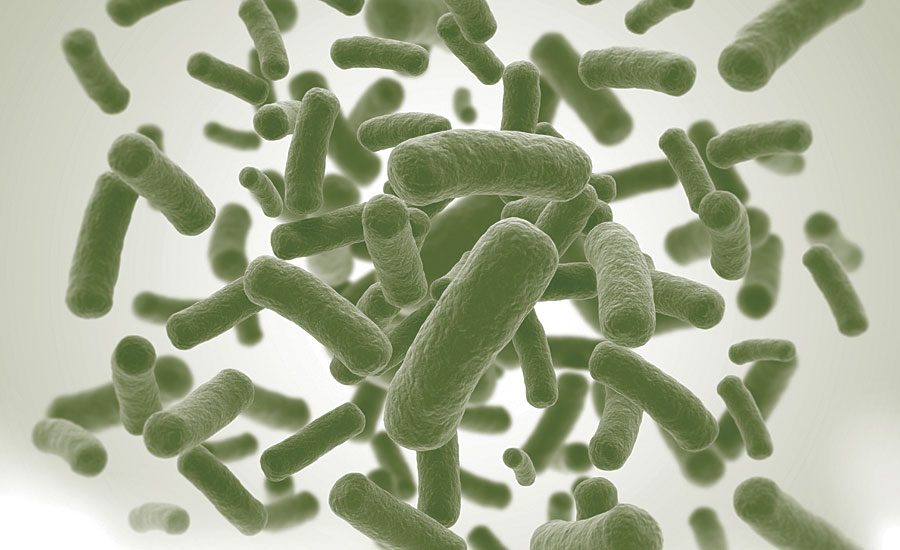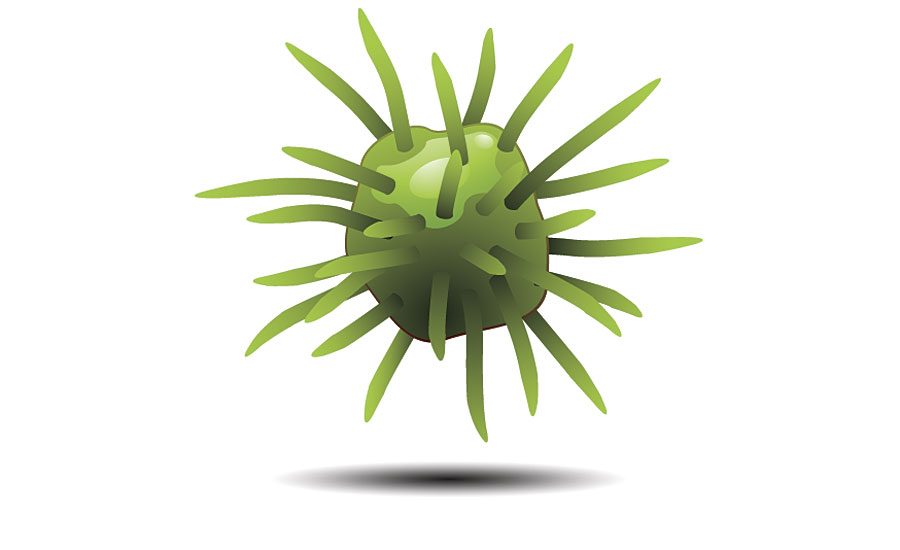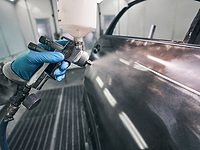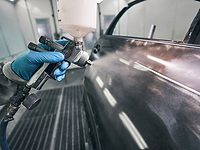It can happen every day, and it can happen to almost any manufacturing facility or product in every city, state, town and country around the world. When was the last time you experienced a microbiological contamination issue? Did your product smell, was it gassing, did it change color, produce a drop in pH, or display several of these noticeable changes? The microorganism, the oldest living creature on Earth, is the cause of all these problems. If you were to simply ignore the symptoms of microbial growth in your facility or product, then the diagnosis would be biodeterioration. The rate of biodeterioration will depend on prevailing environmental conditions and the types of microorganisms involved, whether bacteria, yeast and/or mold. There are many control measures that can be taken to prevent and/or correct biodeterioration. These include specific microbiological control methodologies and the use of biocides within a manufacturing facility.
A substantial amount of money is lost every year due to microbiological contamination occurring to aqueous industrial products and in their manufacturing facilities. Since contamination by microorganisms can occur at various points before, during and even after manufacture, early use of an effective biocide is essential. The proper selection of a biocide and knowledge of its interaction with other materials is critical. The key to formulating is to understand the function of an additive and its chemical or physical behavior in the presence of other components in a specific formulation. This is often not easy or simple. Sometimes very minor amounts of the biocide can have major effects on the formulation and final product performance. The complexity of the biocide and what happens at the interfaces of each is of critical importance. The function of an antimicrobial agent added to a formulation can generally be categorized into two main areas:
- Preventative – prevents a potential problem;
- Corrective – corrects a problem in the manufacturing stage.
The performance of a biocide is dependent upon a combination of microbiology and chemistry. Each class of the biocide has a killing action based on its chemistry, which is either quick or slow acting, and will work versus a broad or narrow spectrum of microorganisms.
Because of their widespread availability and familiarity, general low cost and relative safety, biocides for aqueous industrial products are among the most misused of all chemical agents. Improving biocide use decisions ultimately involves treatment packages that are recommended by the biocide suppliers and approved by the manufacturing facility. However not only is an effective biocide package essential to producing a good product, but also the use and implementation of an effective plant hygiene program to coincide with the biocide package.
Specific Control Methodologies
Due to the change in environmental regulations, the use of some types of biocides has been restricted, and many manufacturing facilities are finding it increasingly difficult to control microorganism contamination. Combined with poor housekeeping practices and unrecognized causes of microbiological contamination, biodeterioration problems in these facilities could have disastrous results. Due to poor housekeeping practices, microorganisms can flourish in many systems and cause significant problems. These problems are common in any type of facility. Because of the environmental regulations instituted today, many facilities have had to reevaluate their current biocide program, often leading to changes in the way they treat their products. By working with a biocide supplier, an effective plant sanitation program can serve to address indicators of microorganism contamination, their symptoms, conditions for growth and ultimately lead to an optimum biocide treatment program.
A well-defined and faithfully executed sanitation program is the basis for effective microbiological control. Without it, biodeterioration is almost certain regardless of the recommended biocide. The following list provides a proven series of tactics to help keep facilities free from microbiological contamination:
1. Keep mixing, holding, pre-mix and storage tanks free of skins. Periodically (every six months) remove skin build up. Follow this with either a steam cleaning or rinse with a quick-kill biocide or bleach-like substance.
2.Remove residual water from tanks, vessels, hoses and other equipment. This residual water can stagnate, become contaminated and spoil new product added to the tanks, vessels, hoses and other equipment. Drain the water, or further treat it with a biocide (usually a quick-kill, short-term preservative) to prevent contamination.
3. Cover any pipes not in use. To prevent skin formation, flush inlet or outlet pipe with water, dry them out and then cap them.
4. Know the source of incoming water. River, well and water from other areas are notorious for causing biological problems. Proper use of a quick-kill biocide can help to eliminate this source of contamination.
5. Store hoses on racks in an “inverted U” position. Don’t leave hoses on the facility floor. Water and old product, raw materials, etc., can accumulate and facilitate microorganism growth.
6. Check the raw materials for growth as they are received. Many times suppliers will not add a preservative to them or they add too little so they are more readily susceptible to growth before you use them. Cover raw materials when not in use; if left uncovered they are subject to airborne organisms and can become contaminated.
7. Periodically change your measuring devices, pails, containers, etc. Over time, these materials can retain excess raw materials that are quite susceptible to degradation. These old materials, when added to a fresh batch of product, often become a serious source of contamination.
8. Review your biocide program. Ask your biocide supplier to follow a regular schedule for reviewing your preservative treatment program, so adjustments can be made as your system needs change.
When examining the above areas for microbial contamination, it is best to utilize rapid detection methods, since a slight contamination problem at the beginning of the process can turn into a disaster by the end of the day. One such rapid detection method is the use of the ATP bioluminescence assay, which is based on the measurement of adenosine triphosphate (ATP). ATP is a substance present in all living cells. Microorganisms are detected by means of the light that is emitted when ATP reacts with Luciferin in the presence of the enzyme Luciferase. The light produced is measured by a sensitive photon counter called a luminometer and a result, indicating the amount of cellular material present, is expressed in relative light units (RLU). Traditional methods for routine biological monitoring have relied upon standard plate counts, which can take anywhere from 48 hours up to seven days of incubation before a result can be reported. The advantage of using the ATP bioluminescence assay is that the level of microbial contamination within a facility can be determined in 2-3 minutes. These results can then be disseminated to the production and technical personnel with the facility so that corrective action can be taken immediately.
To effectively utilize an ATP luminometer for the quantification of ATP in raw materials and finished products, one must establish a protocol that will provide reliable and reproducible results. To handle materials that have high viscosity and/or are opaque, a dilution series using a sterile diluent may be required to minimize the quenching effects. Care must be taken not to dilute the sample to extinction.
Once a workable baseline is established the luminometer can be a very effective field tool to quickly monitor the microbiological load in raw material and finished products. In addition, surface monitoring of critical process equipment such as storage tanks, transfer hoses, etc. can be measured to determine the amount of biofilm build up.
Methods or prevention are superior to methods of eradication. Practicing these recommendations is a prerequisite for excellent biocide performance. An unclean plant overtaxes the biocide and inhibits its effectiveness in controlling microbiological growth. Together a good housekeeping program, clean water and use of a broad-spectrum preservative are the major defenses against system spoilage and the winning combination for consistent production of high-quality products.
Use of Biocidal Products
Biocides for aqueous industrial systems are available to work both in the can or batch, and in the dried film. For this reason many manufacturers include a biocide in the formulation so it can kill both bacteria and yeast that can be present. The biocides used in aqueous industrial markets can be grouped into two classes:
In-can preservatives– these are chemical compounds that are added to formulations during manufacture to prevent biodegradation. Bacteria and yeast are often introduced to the formulation during manufacturing and can come from the raw material or from poor plant hygiene practices. There are a number of chemical actives used for prevention of in-can microbial growth. The biocide is usually added as early as possible in the production process to prevent in-can growth of undesirable organisms. The problem is more serious in the case of water-based systems than it is for solvent-based systems, as the presence of the solvent tends to act as a deterrent for microorganism growth. In-can preservatives for water-based systems are used to protect various products. Some examples of materials used in formulating product most susceptible to microbial attack are emulsifiers, stabilizers and cellulosic thickeners.
Dry film fungicides/mildewcides– these chemicals are used as performance additives in both aqueous and solvent-based systems to inhibit fungal and algae growth in the dry films to protect against premature failure. The growth of organisms such as mold, mildew and algae is very undesirable from an appearance point of view. These organisms also cause the physical breakdown of the film, which can lead to an increase in porosity of the surface of the film and subsequent loss of adhesion to the substrate. Moisture also may contribute to the growth of fungus, which can decay a wood substrate. The main requirement for a dry film biocide is low water solubility. The biocide is designed to prevent contamination of the film over time, and it is essential that the active ingredient is not leached out from the product. Due to the requirement for fungicidal and algicidal activity, combinations of biocides are usually used.
Biocide dosage depends largely on the susceptibility of a particular formulation. Too low of a dosage makes a system vulnerable to degradation. Biocide suppliers integrate a series of factors to calculate a specific system’s dosage requirements. However, changes in the system may affect the biocide demand; the dosage should be monitored regularly to verify appropriate levels. A common scenario -a contamination issue will weaken the biocide system, and left unchecked, leaves insufficient protection against future infection.
In today’s industrial biocide market, the development of new, unique biocidal products is at a standstill; new molecules are closely regulated, expensive to develop and time consuming to register. The safety and toxicity concerns associated with the products and their components discourages market entry by new manufacturers, although fine chemical companies occasionally enter the market by producing one of the more popular biocidal molecules. As a result, most biocide products are at least three decades old and have more than one manufacturer.
As environmental regulations, consumer consciousness and concerns about the sustainability of chemicals in the environment continue to place manufacturers under pressure to decrease the use of biocides in their formulations, the need to develop “environmentally sustainable” alternatives grows. In today’s market there is an unexplored approach being instituted that offers an ingenious use of current technologies with a spin on uniqueness through the power of custom blending of biocides. Being able to custom blend various biocides is not only a unique marketing strategy, but it allows for the introduction of custom blends that can improve the overall effectiveness of a biocide package, improve the economics of the biocide treatment program and contribute to an environmentally sustainable alternative to current programs. Custom blending offers customers the ability to blend multiple actives at various ratios designing an efficacious, economical and environmentally sustainable treatment package based on specific customer requirements.
The benefit to this practice is to offer manufacturers of the custom blend the ability to meet defined targets for toxicity, biodegradation and bioaccumulations. The program will be recognized by the customer as environmentally sustainable in that it can reduce the chemical footprint of the environment, create the opportunity to feed less chemical and ship nonhazardous products. The program will be efficacious because with blended ratios there is the opportunity to optimize the performance of the biocide and improve the overall efficiency of the manufacturing operations. Finally from an economic standpoint, there is the ability to reduce treatment costs, chemical inventory and shipments costs. All these benefits are designed to meet the environmental, efficacy and economical demands of today.
Conclusion
The use of chemical agents for sterilization, disinfection and preservation has increased our life expectancy, provided protection to finished goods and prevented the disruption of industrial processes. The development of an effective biocide treatment program is very crucial for an industrial facility. Identifying and controlling problem spots in a manufacturing process can limit the extent of contamination, but only the use of a biocide, coupled with good plant hygiene, can prevent microbiological outbreaks and maintain the integrity of the formulation at the plant facility from storage, transfer and transport to the consumer. In today’s market, no single biocide can solve every microbiological problem. As new bacteria emerge and formulations change, the only way to stay on top of changing preservation needs is by working with a qualified biocide supplier whose goal is to develop and help institute an effective biocide program.
References
1. Industrial Antimicrobial Agents, Applications and Markets in Various Global Regions, John Wiley & Sons, Inc., 2000-2016.
2. North America Specialty Biocides 20142, Market Analysis, Kline & Co., Inc., 2014.
3. Disinfectant & Antimicrobial Chemicals, The Freedonia Group, Inc., Market Analysis Report, September, 2014.
4. Russell, A.D.; Hugo, W.B.; Ayliffe, G.A.J. Principles and Practice of Disinfection, Preservation and Sterilization, 1992.
5. U. S. Specialty Biocides Markets, Frost & Sullivan Market Report, 2001.
6. Strategic Review of the Impact of the Biocidal Products Directive, Frost & Sullivan Market Report, 2001.
7. Ash, M.; Ash, I. The Index of Antimicrobials, 1996.
8. US Environmental Protection Agency. EPA. Environmental Protection Agency, n.d. Web. Fall 2014. www.epa.gov/.
9. Distribution of Custom Blend Pesticides and Adjuvants, State of Washington Department of Agriculture, n.d., Web. Fall 2013, www.arg.wa.gov.
10. LuminUltra. LuminUltra. N.p., n.d. Web. Fall 2012. www.luminultra.com/.
11. Science Daily, Microbiology Today, n.d.Web. Summer 2015. www.sciencedaily.com.
12.Eilender, A.; Oppermann, R. Biocides: Bactericides and Fungicides, Handbook of Coating Additives, 1986, pg. 177-193.
13. Holt, J.; Noel, K.; Sneath, P.; Staley, J.; Williams, S. Bergey’s Manual of Determinative Bacteriology – 9, 1994, pg.75, 78-80, 93-94, 178.
14. King, V. Bactericides, Fungicides and Algaecides, Paint and Coating Testing Manual, 1995, pg. 261-267.
15. Russel, A.D.; Hugo, W.B.; Ayliffe, G.A.J. Preservation of Specialized Areas, Principles and Practice of Disinfection, Preservation and Sterilization, 1992, pg. 431-435.
16. Supelco, Inc., Identification of Bacteria by Analysis of Cellular Fatty Acids, Bulletin 767C, 1977.
17. Weber, G., How to Establish and Maintain Effective Plant Sanitation, The Adhesives and Sealants Agenda Europe, 1998, pg.88.









Report Abusive Comment